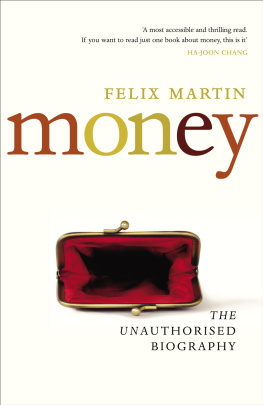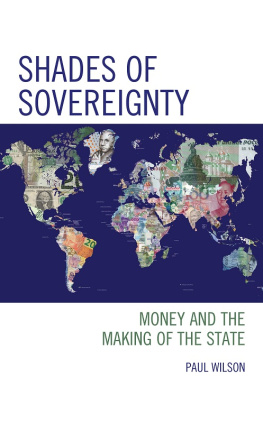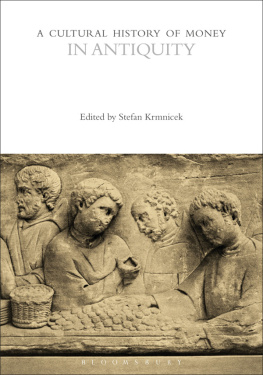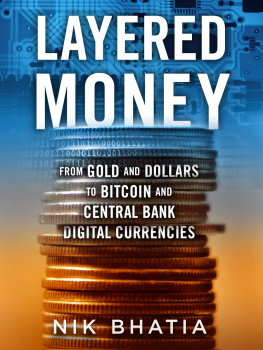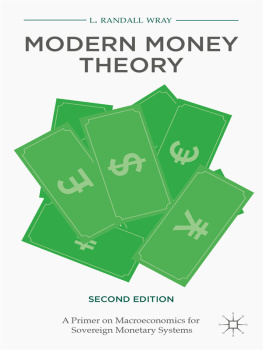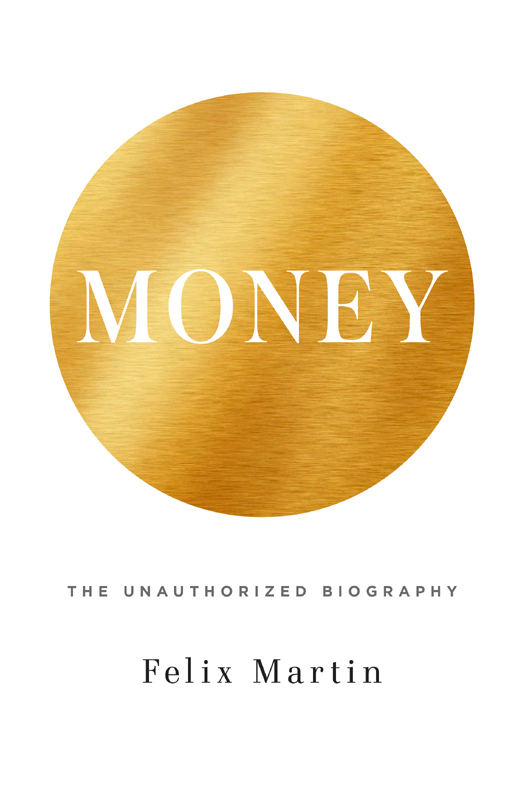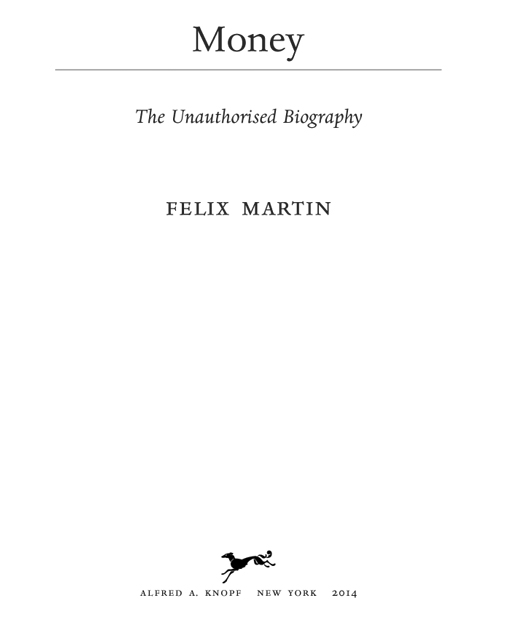THIS IS A BORZOI BOOK
PUBLISHED BY ALFRED A. KNOPF
Copyright 2013 by Failu Ltd.
All rights reserved.
Published in the United States by Alfred A. Knopf, a division of Random House LLC, New York, and in Canada by Doubleday Canada, a division of Random House of Canada Limited, Toronto, Penguin Random House Companies. Originally published in Great Britain by The Bodley Head, a division of the Random House Group Limited, London, in 2013.
www.aaknopf.com
Knopf, Borzoi Books, and the colophon are registered trademarks of Random House LLC.
Library of Congress Cataloging in Publication Data is available.
ISBN 978-0-307-96243-0 (hardcover) ISBN 978-0-307-96244-7 (eBook)
Jacket design by Evan Gaffney
v3.1
To Kristina
Contents
12 Hamlet Without the Prince:
How Economics Forgot Money
1 What Is Money?
Everyone, except an economist, knows what money means, and even an economist can describe it in the course of a chapter or so
A.H. Quiggin, A Survey of Primitive Money: the Beginnings of Currency, p. 1
THE ISLAND OF STONE MONEY
The Pacific island of Yap was, at the beginning of the twentieth century, one of the most remote and inaccessible inhabited places on earth. An idyllic, subtropical paradise, nestled in a tiny archipelago nine degrees north of the equator and more than 300 miles from Palau, its closest neighbour, Yap had remained almost innocent of the world beyond Micronesia right up until the final decades of the nineteenth century. There had, it is true, been a brief moment of Western contact in 1731 when a group of intrepid Catholic missionaries had established a small base on the island. When their supply ship returned the following year, however, it discovered that the balmy, palm-scattered islands of Yap had not proved fertile ground for the Christian gospel. The entire mission had been massacred several months previously by local witch doctors aggrieved at the competition presented by the Good News. Yap was left to its own devices for another one hundred and forty years.
It was not until 1869 that the first European trading postrun by the German merchant firm of Godeffroy and sonswas established in the Yap archipelago. Once a few years had passed, with Godeffroy not only avoiding summary execution but prospering, Yaps presence came to the attention of the Spanish, who by virtue of their colonial possessions in the Philippinesa mere 800 miles to the westconsidered themselves the natural overlords of this part of Micronesia. The Spanish laid claim to the islands, and believed that they had achieved a fait accompli when in the summer of 1885 they erected a house and installed a Governor in it. They had not counted, however, on the tenacity of Bismarcks Germany in matters of foreign policy. No island was so small, or so remote, as to be unworthy of the Imperial Foreign Ministrys attention if it meant a potential addition to German power. The ownership of Yap became the subject of an international dispute. Eventually, the matter was referredsomewhat ironically, given the islands track recordto arbitration by the Pope, who granted political control to Spain, but full commercial rights to Germany. But the Iron Chancellor had the last laugh. Within a decade and a half, Spain had lost a damaging war with America, and its ambitions in the Pacific had disintegrated. In 1899, Spain sold Yap to Germany for the sum of $3.3 million.
The absorption of Yap into the German Empire had one great benefit. It brought one of the more interesting and unusual monetary systems in history to the attention of the world. More specifically, it proved the catalyst for a visit by a brilliant and eccentric young American adventurer, William Henry Furness III. The scion of a prominent New England family, Furness had trained as a doctor before converting to anthropology and making his name with a popular account of his travels in Borneo. In 1903 he made a two-month visit to Yap, and published a broad survey of its physical and social make-up a few years later.and songs, which Furness took particular delight in recording for posterity. There was a vibrant native religionas the missionaries had previously discovered to their costcomplete with an elaborate genesis myth locating the origins of the Yapese in a giant barnacle attached to some floating driftwood. But undoubtedly the most striking thing that Furness discovered on Yap was its monetary system.
The economy of Yap, such as it was, could hardly be called developed. The market extended to a bare three productsfish, coconuts, and Yaps one and only luxury, sea cucumber. There was no other exchangeable commodity to speak of; no agriculture; few arts and crafts; the only domesticated animals were pigs and, since the Germans had arrived, a few cats; and there had been little contact or trade with outsiders. It was as simple and as isolated an economy as one could hope to find. Given these antediluvian conditions, Furness expected to find nothing more advanced than simple barter. Indeed, as he observed, in a land where food and drink and ready-made clothes grow on trees and may be had for the gathering it seemed possible that even barter itself would be an unnecessary sophistication.
The very opposite turned out to be true. Yap had a highly developed system of money. It was impossible for Furness not to notice it the moment that he set foot on the island, because its coinage was extremely unusual. It consisted of feilarge, solid, thick stone wheels ranging in diameter from a foot to twelve feet, having in the centre a hole varying in size with the diameter of the stone, wherein a pole may be inserted sufficiently large and strong to bear the weight and facilitate transportation. This stone money was originally quarried on Babelthuap, an island some 300 miles away in Palau, and had mostly been brought to Yap, so it was said, long ago. The value of the coins depended principally on their size, but also on the fineness of the grain and the whiteness of the limestone.
At first, Furness believed that this bizarre form of currency might have been chosen because, rather than in spite, of its extraordinary unwieldiness: when it takes four strong men to steal the price of a pig, burglary cannot but prove a somewhat disheartening occupation,
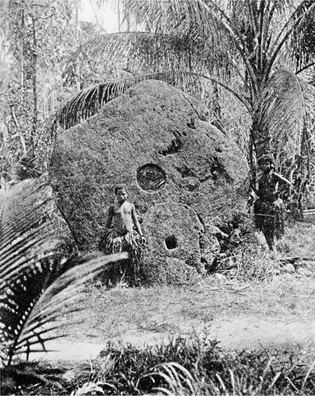
The stone currency of Yap as photographed by William Henry Furness III in 1903, with people and palm trees for scale.
()
When Furness expressed amazement at this aspect of the Yap monetary system, his guide told him an even more surprising story:
[T]here was in the village near by a family whose wealth was unquestionedacknowledged by everyoneand yet no one, not even the family itself, had ever laid eye or hand on this wealth; it consisted of an enormous fei, whereof the size is known only by tradition; for the past two or three generations it had been and was at that time lying at the bottom of the sea!


